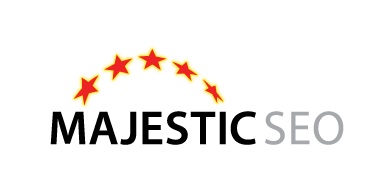 Are you monitoring your backlink profile?
Are you monitoring your backlink profile?
It is no secret Google have become very aggressive when it comes to links and link building strategies: highly optimized anchor text links have suddenly become toxic as they are unnatural. So perhaps branding is the way to go and people are thinking twice before placing questionable links on their money sites.
While link building is still an essential part of your SEO strategy, there is another aspect you need to consider as an everyday part of your optimisation efforts: Monitoring your backlink profile.
Backlink profile monitoring should be an integral part of your ongoing SEO activities. You need to know who is linking out to you, and if there are any suspicious activities, in order to react in real time and avoid a disruptive, (or devastating), penalty.
How you can use Majestic SEO to monitor your backlink profile?
Majestic SEO offers 2 different ways to monitor your backlink profile:
Via a Tracking Report. The link tracking report from Majestic SEO offers a view of Trust Flow, Citation Flow, and other link quality characteristics such as external backlinks, referring IPs, referring domains, and referring subnets: link quality characteristics of any URL or website over time, updated on a daily basis. This report is useful in 2 ways:
- It allows you to follow the link quality of a URL and see if there is any correlation between a change in a URLs position and whether the change was caused by an increase in good (or bad) links. These flow metrics start calculating many link iterations away from the URL you are tracking – meaning there does not have to be a change to the pages that physically link to you, for there to be a change in the page’s fortunes on the web.
- It offers an overview on the rate of growth of your Inbound Links (IBLs). The daily report offered by the tracking report offers strategic insights on a day-to-day basis which you can use to understand what is happening:
- There has been a spike in new IBLs, where are they coming from?
- Are they related in any way to a viral activity performed by the Social media Team?
- Was a link picked up and passed along on Twitter?
- Did the R&D team publish a white paper?
- Was a newsletter published offering a download?
If the answer to any of these questions was YES, then you are safe and should be ready to bet those links are all legitimate.
But what if the answers to all these questions was NO – nobody did anything of the sort; there were no Social Media initiatives, no newsletters, none of your content went viral – then where are these links coming from?
Spikes in the IBL profile should be looked at with suspicion – they could be coming from a site which has nothing to do with us and could have dropped a run of site link in their navigation bar or footer… this deserves your immediate attention. The following graphic taken from a tracking report is the perfect example:
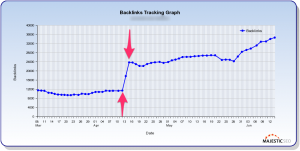
In this case we can see there is a certain trend in backlink profile, then a sudden significant growth over a few days; (in this case the IBLs shot up from just under 12.000 to 24.000). These links were found to be coming all from the same site, a very big portal with thousands of pages that had placed a link in the sidebar.
In very competitive markets competitors can organize a negative link building campaign to discredit you by adding thousands of low quality links, and then by doing so, impacting your trust flow, and boosting your citation flow. The tracking report will keep you up to date and in a matter of days you will be informed of the presence of these undesired and hostile links.
Tracking reports offer top level numbers and information but not the actual links; (they can be found in the Site Explorer under the New tab):
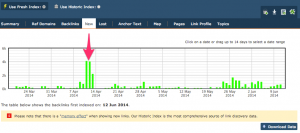
You can see the spike noted in the previous screenshot taken from the tracking report. By hovering over the dates Majestic will reveal total number of backlinks identified and date of discovery; (which is not necessarily the date of creation).
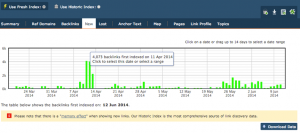
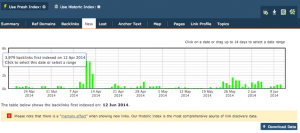
Clicking on the date will retrieve the links and allow a detailed analysis. If the links are legitimate you keep them, if they are not your only option is to disavow them: by doing so you are telling Google you have nothing to do with that inbound linking activity and are taking appropriate action to distance yourself from them; (and by doing so renouncing to any link equity coming from them). The disavow will feed into your link profile and these links will be removed from your link graph. In this way you are preventing any retaliation on behalf of Google when the day of reckoning will come … prevention is better than curing.
Thanks for your time – Sante J. Achille
- Is metadata important in SEO? - October 30, 2023
- A Simplified Approach to Content Creation using NLP - May 11, 2023
- The unknown side of search: when words become numbers - November 18, 2020







Hi there,
I just checked the backlink data of MajesticSEO of my site, and it gave some weird outcomes. It stated that there are +20 new domains which have links to my website, although I was not able to find those links, neither in the source code. The Trust & Citation Flow is also been changed.
Did you hear it more frequently today and is it a data-error, or is it really my case only? In that case I need to clean up. Thanks!
June 19, 2014 at 4:20 pmHi Karel – please put a ticket into support showing us the examples and we can take a look. Generally we would not report a domain unless we found a link there. We can check an exact example.
June 19, 2014 at 4:27 pmIn cases of negative SEO, I don’t think this would be useful…at least with Majestic. I love your metrics but the links just don’t get crawled fast enough for this to be useful. At least for negative SEO.
But if you’re the one building sketchy links to your site than wouldn’t you already know?
Anyway, love the service, keep up the good work.
June 21, 2014 at 6:11 amHi Tyler,
Thanks for the comment. Actually – Majestic’s Crawler is one of the top 10 fastest crawlers in the world, generally. I make that claim based on looking at raw log files from a range of websites around the world and looking at the robots data. Yes, Google crawls faster, but I still think Majestic crawls fast enough (and intelligently enough) to help spot links that might be affecting you negatively. Where we do slow up a little – on purpose – is in taking the time to calculate the flow metrics associated with a URL. This calculation does take 24 hours (and more at times), so whilst we might spot a link within an hour, we still won’t report on it for at least a day. Indeed it is likely to take a couple of days. However – where we are much stronger as a result – is in the quality score that we can then assign to the URL that is linking to you. Any search engine (including Google) would need some period of time to assess whether a URL is spammy or not. Sometimes I guess Google might deem the domain itself to be pre-ordained as contaminated – but in general, the heart of the algorithms work on a URL – not a domain level.
The alternative is to find links faster – maybe via Google WMT or another link data source – but not have any useful or scalable way to know if the link is good, bad or indifferent. I think that the method and velocity we have developed is now about right and should be timely enough for Negative SEO investigations.
June 23, 2014 at 9:22 amThat is absolutely fantastic. Would be great with a direct GWT connection to disavow all unwanted links though. Just select unwanted links, then press a button…Maybe next version?
July 2, 2014 at 2:58 pmThe only way we would consider this is if Google gave Disavow write access via their GWT API as a universal option. Google has funny terms about automated access to an account – in part for security reasons. Not doing that through an officially supported mechanism would be something that might end up as a development cul de sac for us. I also don’t think Google will enable that feature for some time to come, because they seem to want webmasters to feel pain – or at least cast a human eye – over things that webmasters are claiming to be bad data or spam links. That’s probably for the webmaster’s own good in Google’s opinion (I don’t speak for them or have anything other than conjecture in this reply).
July 2, 2014 at 3:44 pmActually I don’t think you would want to do that: Disavow should be performed only after careful consideration and detailed analysis. If you make a mistake you won’t get the link juice back for a loooooong time after pulling the links you mistakenly put in the disavow file. So a word of caution in performing disavows 😉
July 2, 2014 at 4:03 pmTo be able to take all advantages of what you explained above, I need to have an option to be able to upload my disavow file here.
Does that exist and I missed it? Or are you planning to add that feature in the near future?
July 3, 2014 at 12:01 amThe only practical ways to upload URLs are through the API or via https://www.majesticseo.com/reports/url-submitter but these don’t let you flag the URLs as disavowed at the moment I am afraid. However – you could use this excel template to compare our URL list with your Disavow list and thereby clean the list: http://blog.majesticseo.com/research/useful-excel-templates/
July 3, 2014 at 8:23 amI am getting 0 business. How do you fix the backlinks? I think I have an issue there. Thanks, Russ Peterson.
July 3, 2014 at 2:57 pmHi. You have plenty of backlinks – but Majestic provides the data, rather than consultancy. You would be best to ask a trusted SEO to look at your specific site in more detail.
July 3, 2014 at 4:06 pmis there a alert system which warns us for big spikes?
July 3, 2014 at 8:42 pmHi Serbay, no nothing automatic at the moment, but you can see this in the Site Explorer under NEW links
July 3, 2014 at 8:56 pm